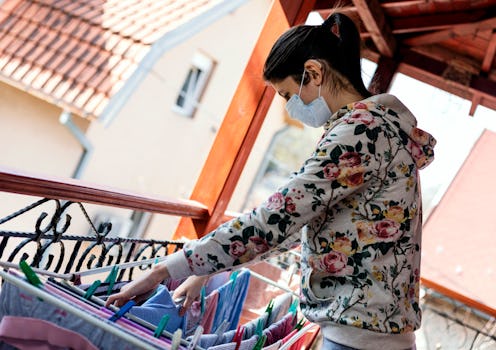
Life in the time of the coronavirus outbreak has altered how people perform even the most mundane activities. With all that separating, washing, drying, and folding involved, doing laundry was already a chore before the pandemic. But these days, it’s somehow even more complicated. While there’s no research available yet confirming just how long coronavirus can live on clothing, experts generally recommend erring on the side of caution. In other words: Wash clothes more frequently, and embrace the concept of having outside and inside clothing. But what happens when you don’t have easy access to a washer and dryer? Or you’d just rather avoid the laundromat altogether? It’s time to take matters into your own hands — literally. Washing clothes by hand is not only more environmentally friendly, it’s also a great way to ensure that your favorite pieces stay in shape for the long term. Plus, experts advise that certain materials should always receive the hand washing treatment.
“Unless you invest in a high-end washing machine and dryer — Miele, for example — hand washing is the best method of cleaning for your delicate items,” Katie Brown, owner of Rytina Fine Cleaners in Sacramento, tells Bustle. “By hand washing, one can control those extremely damaging conditions that break down fibers, like heat, mechanical cycles, etc., therefore prolonging the lifespan of the garments.”
Ahead, you’ll find everything you need to know about washing your clothes by hand.
What products and tools do I need to hand wash clothes?
First, you need someplace to actually wash the items: Think a basin, sink, or tub. Water and detergent are the other essentials.
“The type of detergent you should use depends on what you’re washing,” explains Gwen Whiting, co-founder of The Laundress. “For instance, everyday laundry like cotton, linen, and durable synthetics can be washed with our Signature Detergent. But wool and cashmere require a fabric-specific detergent like our pH-neutral Wool & Cashmere Shampoo.”
You may also want to stock up on stain remover to tackle any pesky spots.
Which items should be hand washed?
Overall, hand washing is a gentler way to clean delicate fabrics or fabrics considered dry clean only, including silk, some synthetics, lace, wool, cashmere, and other knits.
“Embellished items, bathing suits, bras, and delicate underwear should also be hand washed,” says Lindsey Boyd, co-founder of The Laundress. “These can all go in a washing machine if you use the right detergent, spin cycle, and water temperature. But if you have the time to hand wash, it’s always the best way to go.”
How long does it take to hand wash clothes?
Plan on anywhere from 15 minutes to one hour and 15 minutes, which doesn’t include dry time. The time you’ll need to set aside depends on whether your clothes have stains and the size of your laundry load.
“The more you have to wash, the longer the process will take,” Whiting says. “We always recommend soaking items for up to 30 minutes after you’ve added the detergent to the water, but you can skip this step if you’re short on time.”
Alright, so how do I actually hand wash my clothes?
If you’re washing cotton, linen, and/or durable synthetics (such as polyester), run warm or hot water long enough to cover the garments. Next, add the correct amount of detergent depending on the load size — two to four capfuls should be good.
“Agitate the water with your hands to create a soapy solution and let the garments soak for 30 minutes,” Boyd explains. “Remove the laundry from the tub by pressing each garment against the edge of the tub, and placing in a clean bucket or sink. Then, open the drain to release the soapy water, and close the drain before filling the tub back up with clean warm water.”
Next, place the garments in the clean warm water. Swirl thoroughly to rinse away suds, and drain one more time. If any garments still have suds, run them under the faucet until the rinse water is clear. Don’t wring garments, which could damage fibers. Instead, press garments against the edge of the tub to get rid of excess water. Hang or lay flat to dry. If you’re washing silk or delicate synthetics, follow the same steps in a sink or wash basin, using cool water and a detergent specifically for delicates.
What are the benefits of hand washing versus machine washing?
Put simply: Washing clothes by hand helps them last longer. “Hand washing increases the longevity of textiles by preserving fibers and detailing,” Boyd says. “In a washing machine, fabrics can snag inside the drum, and it can disrupt the fibers or detailing. Using a water temperature that’s too warm or a spin cycle that’s too aggressive can also disrupt delicate fabrics.”
What else do I need to know about hand washing clothes?
When you’re done with the washing part, it’s important to remember that some fabrics need to stay away from the dryer. “Fabrics like silk, some synthetics, lace, wool, and cashmere should always be air dried,” Whiting says. “Lay them on a flat surface or clean towel. Be sure they’re not near a heat source like a window or radiator.”